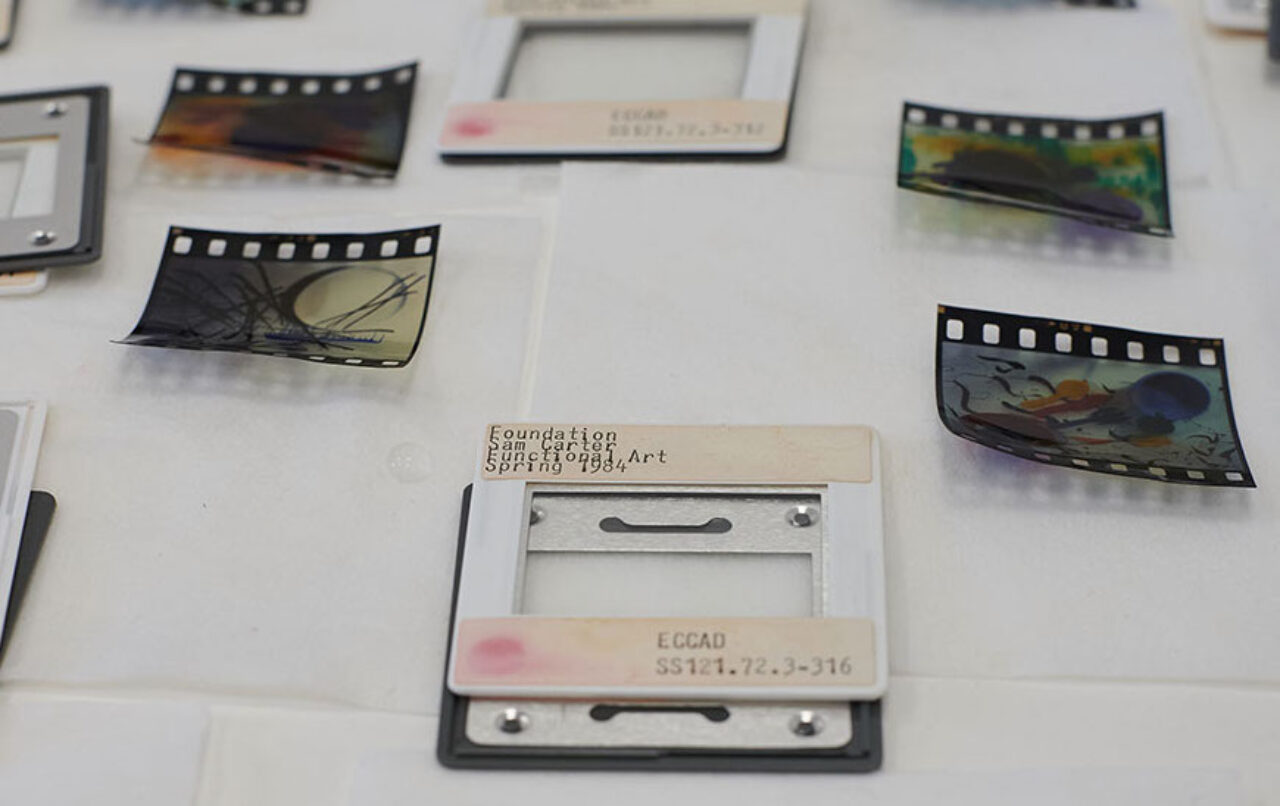Meet the Student Slide Restoration Assistants - ECU Archives
Posted on | Updated
Filed in Faculty, Staff, Students

Two students, Valeria Paz García and Leo Mah, were hired in May 2021 to restore water damaged archival slides. To date the students have made incredible progress - so far the two students have cleaned and restored over 10,000 slides.
As a result of the fire on the campus in October 2019, water migration into the ECU Archives caused considerable damage to the materials housed in the space. This included water damage to 22,000 colour slides which represent the history of Emily Carr University, including original photo documentation of Grad Show, Foundation Show, exhibitions and student/faculty/staff activities from the late 1970’s until the early 2000’s.
Both Valeria and Leo came to the position interested in photography. Leo had experience working with his grandfather’s extensive slide collection: “My introduction to photography is rooted in the collection of my grandfather's slide film. When I restore this work, I feel curiosity and awe, but now I also have the critical skills to appreciate the work at another level.”
“One of my favourite places on the campus is the library. I love studying and working on projects here,” said Valeria. Valeria expressed that she was attracted to the job because it brought together several of her interests. ”Besides studying communication design, one of my favorite pastimes is photography. Thus, this job mixed my love for history and photography perfectly together.”
The slides are currently stored in a freezer to ensure that no further damage occurs. The longer slides sit in room temperature water, the more damaged they become. Valeria has done some testing with discarded commercial slides and has found that after about 10 hours of sitting in water, the image starts to peel. Beginning with the yellows, the colours begin to bleed and the emulsion comes off of the support. Freezing the slides stops this deterioration.
Slide restoration work is very detailed and time consuming. Each slide is removed from its damaged housing and left to thaw. Some of the slides are encased in ice and have water trapped in the slide mounts.
These slides need to be immediately triaged and removed from the cases. According to Valeria, “the most challenging part of the slide restoration work is working fast enough so the ice does not melt before taking the film out of the plastic cases. Then later, rinse it and let it dry.” The damaged slides get dipped in water to clean them and are left to air dry with the emulsion facing up to prevent further damage.
After viewing thousands of images, both students have a unique perspective and understanding of the history of Emily Carr University. Leo did not have a single favourite image but expressed that many images have stuck with him. Some of Valeria’s favourite images were from the Graphic Design program in the 1980’s.
“Due to working against the clock to restore the slides, I don’t have enough time to admire each image. One of my favorite binders was the “Graphic Design Student Work 1982-1983”. The slides were very satisfying to look at. But the most memorable ones are the ones that are entirely deteriorated. We’ve only had three slides that got damaged beyond repair, thankfully. However, they are fascinating because you can see the different layers of the chemicals used to divide an image. The last colour from the film to dissolve is blue; thus, the damaged images have spots in different shades of blue.”
The Library and Archive team would like to extend a huge thank you to both Valeria and Leo for the time and care they have put into restoring the slide collection. The slides have been rehoused into acid free boxes to protect them into the future. Once all of the slides have been restored and rehoused, the goal is to begin a multi-year project to digitize and make them available online.